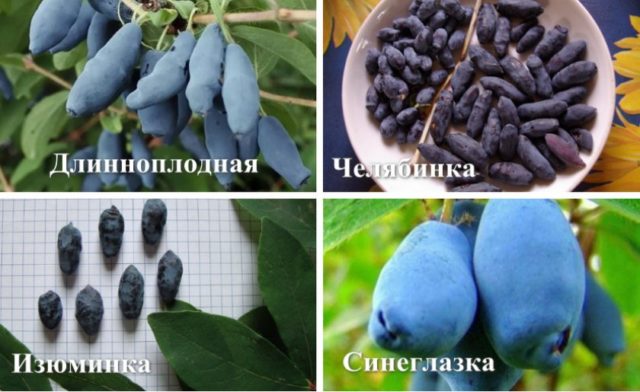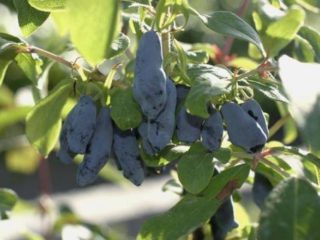Content
Honeysuckle is not only a beautiful but also a useful shrub. Due to the large number of varieties and hybrids, you can choose the plant you like the most, which will be suitable for the growing region. The description of the variety, photos and reviews of the Honeysuckle Sorceress will help you make the right choice and purchase a large-fruited, winter-hardy shrub that will not only bring a stable harvest, but also become a decoration of your personal plot.
Description of Honeysuckle Sorceress
Honeysuckle Sorceress was bred by Russian scientists relatively recently. The plant was obtained by crossing the Kamchatka honeysuckle, thanks to which the variety turned out to be cold-resistant and resistant to diseases.
Despite its young age, the variety has gained great popularity among gardeners. The plant forms a slightly spreading bush or small tree, up to one and a half meters high. In spring, dark olive, oblong leaves with a matte surface appear on thick, red-brown shoots.
In April, the bush is covered with wax flowers. After that, large, oblong dark blue berries appear on the plant. Each weighs up to 1.5 g. A thin, dense skin covers the juicy, delicate pulp of sweet and sour taste.
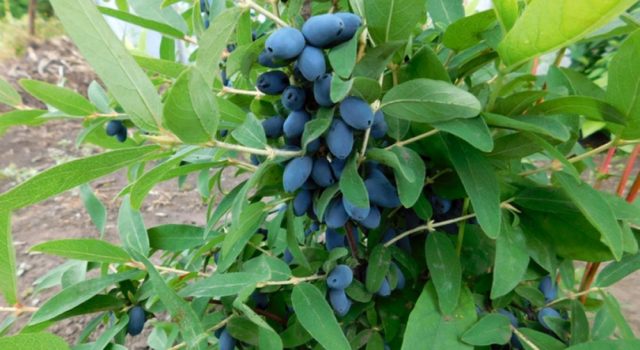
Overripe berry from the bush does not crumble and does not sour in the sun
In addition to its high taste, the variety is hardy, undemanding to care for, immunity to diseases, high-yielding and well transported over long distances.
Honeysuckle Sorceress is a cold-resistant variety. An adult shrub can withstand temperatures as low as -40 ° C, but flower buds freeze out at -5 ° C.
The plant is unpretentious and develops well with a lack of moisture. For this reason, the Sorceress honeysuckle grows well and develops in regions with dry summers. But when growing in the south of the country, it is important to remember that the taste and presentation of the crop depend on watering.
Honeysuckle Sorceress is a fruitful variety, subject to agricultural technology, up to 3 kg of berries can be removed from an adult bush. By the timing of fruiting, the plant is considered medium early, it all depends on the place and region of growth. In central Russia, when grown in a sunny place, biological ripeness occurs in late June or mid-July.
The berry has a good taste and beneficial properties.
In folk medicine, not only berries are used, the entire aerial part is used to prepare infusions and decoctions. In cooking, the harvested crop is valued fresh; compotes, preserves and jams are prepared from it. Also, the berry can be frozen and dried.
Honeysuckle Sorceress, like any garden plant, has positive and negative sides.
The pluses include:
- large-fruited;
- good taste and presentation;
- high keeping quality and good transportability;
- compact size;
- unpretentious care;
- high frost resistance and immunity to diseases.
Many gardeners refer to the disadvantages of the variety:
- infertility;
- low resistance to damage by insect pests;
- with a lack of moisture, the pulp acquires a bitter taste.
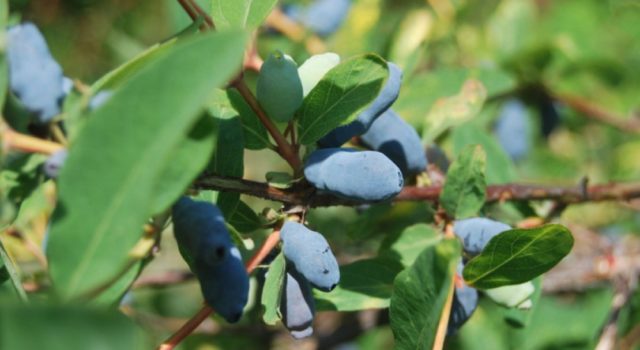
The pulp contains vitamins and minerals that increase immunity, strengthen blood vessels and improve cerebral circulation
Planting and caring for honeysuckle Sorceress
To get the maximum yield from a bush, you need to choose the right planting material, know the place, planting time and care rules. It is also important to study the varietal characteristics of the tree, the advantages and disadvantages, view photos and videos about the edible honeysuckle Sorceress.
It is best to buy a seedling in a specialized store at the age of two years. A healthy plant should have strong shoots with brightly colored bark. The root system should be free of mechanical damage and signs of rot. The optimum height of the seedling is 40-50 cm.
The Sorceress honeysuckle is planted in spring and autumn. Autumn rooting is carried out a month before the onset of frost. Spring - after warming up the soil and the end of spring frosts.
Honeysuckle Sorceress grows well and bears fruit in a sunny place with fertile, well-drained soil, neutral acidity. In the shade, the plant will develop well, but the yield will be minimal, and the taste is not up to par
It is better to plant bushes along a fence or other buildings, as drafts and gusty winds can damage a young seedling.
Landing rules:
- A 40x40 cm hole is dug in the selected area.
- A drainage layer and nutrient soil are laid at the bottom.
- At the seedling, the roots are straightened and set in the center of the hole.
- The void is filled with soil.
- The top layer is tamped, spilled and mulched.
- After the soil subsides, the root collar should be located above the soil surface or deepened by 3 cm.
The growth and development of the shrub depends on care. Honeysuckle for full fruiting requires regular watering, timely feeding and pruning.
In cold weather, the bush is irrigated 3-4 times a season: during the period of active growth, at the time of flowering and fruit formation, in the fall - a month before the onset of cold weather. Watering should be abundant, at least a bucket of settled water is consumed for each adult plant. Irrigation is carried out strictly at the root, since when moisture enters the foliage, fungal diseases appear.
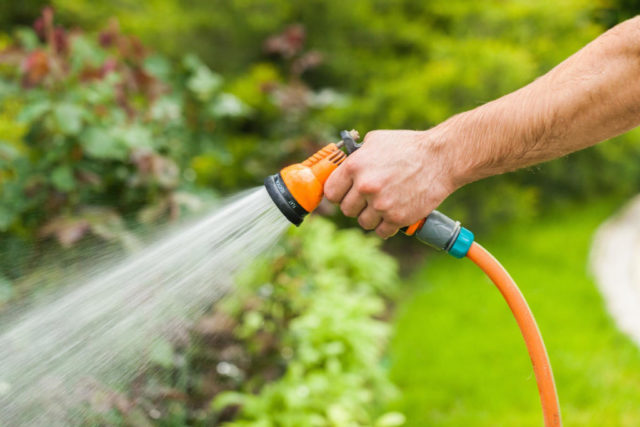
Watering should be abundant and regular.
After each watering, the trunk circle is loosened and mulched, and weeds are removed, since it is a carrier of diseases and pests.
The first top dressing is applied 3 years after planting. Fertilization scheme for each plant:
- during the growing season - urea;
- in the phase of flower and fruit formation - double superphosphate and potassium sulfate;
- in the summer, after removing the berries, - nitrophoska;
- in the fall - compost.
In spring and autumn, sanitary and anti-aging pruning is carried out. During the procedure, old, damaged branches are removed, as well as shoots and root shoots that interfere with each other. To stimulate growth, adult skeletal parts are shortened, leaving branches of 30-40 cm.
Honeysuckle Sorceress is a winter-hardy culture, so it does not need shelter for the winter. But, despite the cold resistance, it is better to prepare the bush for future cold weather:
- The plant is spilled abundantly with settled water. The waterlogged soil does not freeze so much, so the root system will not suffer even from severe frosts.
- After irrigation, shallow loosening is carried out, and the tree-trunk circle is sprinkled with wood ash.
- To increase immunity, the aerial part is sprayed with a solution of copper sulfate.
Honeysuckle pollinators Sorceress
Blue Honeysuckle Sorceress is a self-fertile variety. To obtain the maximum yield, varieties are planted next to the bush that bear fruit at the same time. As pollinators for the Sorceress honeysuckle are suitable:
- Long-fruited;
- Chelyabinka;
- Zest;
- Sineglazka.
Reproduction of edible honeysuckle Sorceress
Honeysuckle The Sorceress reproduces by bending and dividing the bush.
To root the branches, the strongest shoot is chosen, laid in a trench, leaving the top above the ground. Sprinkle the branch with nutritious soil, spill and mulch. A year after rooting, the young plant is separated from the mother bush and transplanted to a permanent place.
By dividing the bush, honeysuckle is propagated during transplantation. The plant is dug up and divided into the required number of divisions. Each part must have healthy shoots and a strong root system. For better rooting, before planting in a permanent place, the cuttings are kept in a growth stimulator.
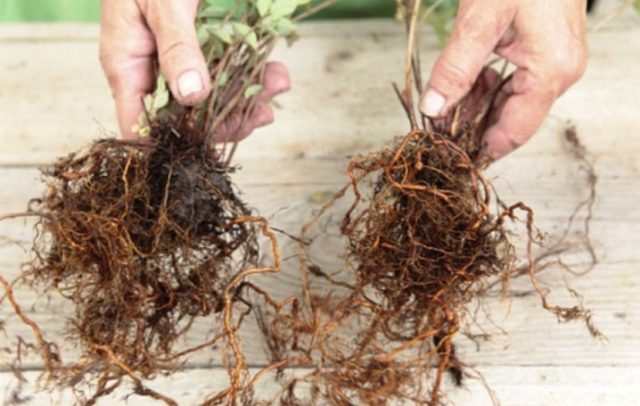
By dividing the bush, the plant is propagated exclusively in autumn.
Diseases and pests
The Kamchatka Sorceress honeysuckle has a strong immunity to many diseases. But in order for the plant to grow and develop safely, it is necessary to carry out preventive measures in a timely manner. For this:
- In the bud swelling phase, the bush is sprayed with urea, Bordeaux liquid or copper sulfate.
- During the flowering period, the plant is treated with the preparation "Biotlin", "Calypso".
- After flowering, honeysuckle cannot be treated with chemicals, so the shrub is sprayed with biologics "Gaupsin", "Fitosporin".
Conclusion
The description of the variety, photos and reviews of the Sorceress honeysuckle show how attractive the plant is, and how it is suitable for growing on a personal plot. Subject to agricultural technology, the shrub will delight you not only with a decorative look, but will also bring a good harvest of tasty and healthy berries. The harvested fruits can be used fresh or canned.
